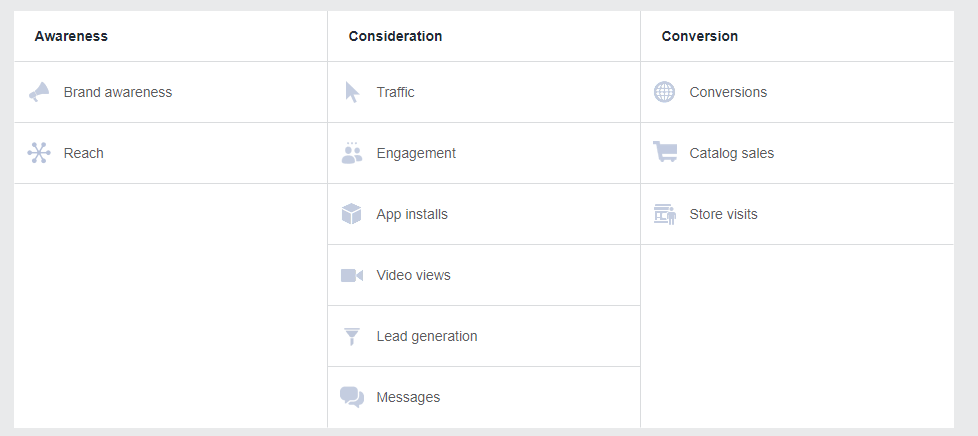Social Media and RACE
Figure 5.19 Facebook Ad Objectives

Facebook has divided its ad objectives into three categories that almost perfectly align with the RACE framework: “Awareness” is associated with Reach, “Consideration” with Act, and “Conversion” with Convert. Let’s examine each objective in more detail.
Under the Awareness category, brand awareness “increases overall awareness for your brand by showing ads to people who are more likely to pay attention to them,” and reach “shows ads to the maximum number of people in your audience while staying within your budget.”
What is the difference? While both align with Reach objectives, brand awareness is designed to help advertisers find the audiences most likely to recall their ads. The goal is to increase brand recall, and this ties to Facebook “Estimated ad recall lift.” Reach maximizes the number of unique people who will see your ad while capping the frequency of impressions (e.g., one a day).
Objectives in the Consideration category overlap with all three stages.
Traffic addresses a Reach objective as it aims to grow “the number of people who are visiting your site, app or Messenger conversation,” but it is also associated with Act because it aims at “increasing the likelihood they’ll take a valuable action when they get there.”
Engagement can be seen as both an Act and an Engage activity: it wants to “get more people to follow your page or engage with your posts through comments, shares and likes. You can also choose to optimize for more event responses or offer claims.”
App installs can be seen as both Act and Convert activities (depending on the strategic goal of having people install your app; if the app is free and purchases happen within it, it’s a lead generation activity; if it is a paid app, it’s a convert activity).
Lead generation includes a menu where users can directly enter their personal information. It is an Act activity that aims at creating leads.
In the last category, Conversion ads align with the Convert stage by helping advertising to convert users into customers.
These categories use the Facebook ad delivery algorithm differently, with Awareness objectives targeting ads to people more likely to respond to Awareness generation and Conversion objectives to people more likely to convert. Some objectives also offer specific types of ads, such as a catalog (catalog sales), a form (lead generation), or a redirection to app installs (app installs).
The last important strategic piece to cover associated with social media is their targeting capabilities, or how they allow you to display ads to specific groups of people. All platforms will allow you to target your ads based on key customer variables, such as demographics, location, and interests, and each also has some specific targeting capabilities. For example, LinkedIn allows you to use LinkedIn audience segments to programmatically reach professional audiences based on their company size, seniority, professions, and other key professional variables.
Most platforms allow for behavioral targeting, where ads are delivered based on purchase behaviors or intents or people who have a specific kind of connection to your page, app, group, or event. For example, advertisers could target any users that have engaged with their content across the Facebook family of apps and services.
After Facebook introduced the highly useful Lookalike audience option in 2013, other major advertisers such as Google followed suit. Lookalike audiences use platforms’ algorithms to create groups on social networks that resemble other groups. This is a new and unique way to target that was never before possible and can help companies unearth some group of consumers who would be highly qualified but have not yet been identified by the company. A lookalike audience could be based on a previously highly engaged audience (i.e., finding another group of consumers that shares some commonalities that will also make them highly engaged) or an existing segment of customers.
Payment structures for social media advertising are typically one of the following:
- CPM (cost per thousand): Pay every time 1,000 users view your ad.
- CPC (cost per click): Pay when a user clicks on your ad.
- CPA (cost per action or cost per acquisition): Pay only when an advert delivers an acquisition after the user clicks on the advert (definitions of acquisitions vary depending on the site and campaign and may be a user filling in a form, downloading a file or buying a product).

No Comments